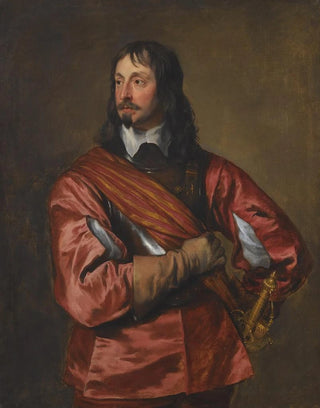Art print | Portrait of Sir John Mennes - Antoine van Dyck


View from behind

Frame (optional)
The "Portrait of Sir John Mennes" by Antoine van Dyck is an iconic artwork that transcends time and space, revealing the subtleties of an era when portrait painting reached its zenith. This painting, both majestic and intimate, captures not only the appearance of its subject but also his essence, status, and character. Sir John Mennes, a man of letters and a friend of Van Dyck, is depicted with a dignity that evokes both nobility and vulnerability. The soft light bathing the portraitist's face creates an almost tangible atmosphere, inviting the viewer to immerse themselves in the universe of 17th-century English court life.
Style and uniqueness of the work
Van Dyck's style is immediately recognizable, blending a virtuoso technique with deep emotional sensitivity. In "Portrait of Sir John Mennes," the artist employs a palette of rich, nuanced colors, ranging from warm tones to delicate shadows, bringing his subject to life. The texture of the carefully rendered clothing demonstrates Van Dyck's mastery in depicting fabrics, while Mennes's penetrating gaze seems to tell a story beyond mere features. Every detail, from the folds of the drapery to the sparkle in the eyes, is thoughtfully designed to create a harmonious composition, where the subject and background blend in a visual dance. This work does not merely depict an individual; it evokes a certain grandeur, an aura that transports us to a bygone era.
The artist and his influence
Antoine van Dyck, born in Antwerp in 1599, is one of the greatest portraitists in art history. A pupil of Rubens, he developed a personal style that combines elegance and realism. His time in England, where he became the official painter to King Charles I, marked a turning point in his career. Van Dyck influenced not only his contemporaries but also generations of artists who followed. His approach to portraiture, centered on the psychology of the subject and refined staging, redefined artistic standards. The "Portrait of Sir John"

Matte finish

View from behind

Frame (optional)
The "Portrait of Sir John Mennes" by Antoine van Dyck is an iconic artwork that transcends time and space, revealing the subtleties of an era when portrait painting reached its zenith. This painting, both majestic and intimate, captures not only the appearance of its subject but also his essence, status, and character. Sir John Mennes, a man of letters and a friend of Van Dyck, is depicted with a dignity that evokes both nobility and vulnerability. The soft light bathing the portraitist's face creates an almost tangible atmosphere, inviting the viewer to immerse themselves in the universe of 17th-century English court life.
Style and uniqueness of the work
Van Dyck's style is immediately recognizable, blending a virtuoso technique with deep emotional sensitivity. In "Portrait of Sir John Mennes," the artist employs a palette of rich, nuanced colors, ranging from warm tones to delicate shadows, bringing his subject to life. The texture of the carefully rendered clothing demonstrates Van Dyck's mastery in depicting fabrics, while Mennes's penetrating gaze seems to tell a story beyond mere features. Every detail, from the folds of the drapery to the sparkle in the eyes, is thoughtfully designed to create a harmonious composition, where the subject and background blend in a visual dance. This work does not merely depict an individual; it evokes a certain grandeur, an aura that transports us to a bygone era.
The artist and his influence
Antoine van Dyck, born in Antwerp in 1599, is one of the greatest portraitists in art history. A pupil of Rubens, he developed a personal style that combines elegance and realism. His time in England, where he became the official painter to King Charles I, marked a turning point in his career. Van Dyck influenced not only his contemporaries but also generations of artists who followed. His approach to portraiture, centered on the psychology of the subject and refined staging, redefined artistic standards. The "Portrait of Sir John"






